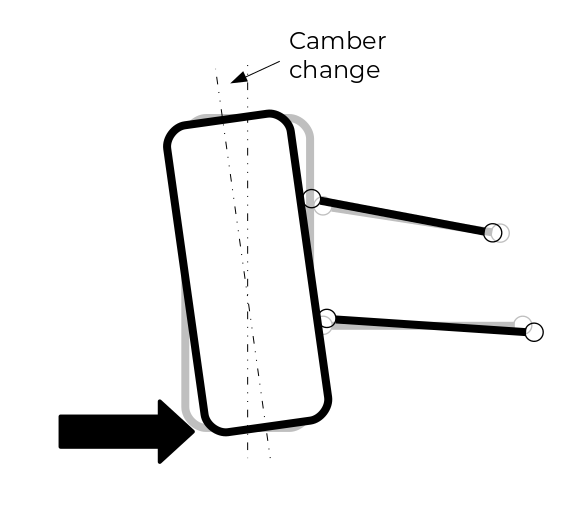Camber Compliance – Suspension KPI
Camber compliance (the inverse of camber stiffness) is a measure of the compliance of a suspension system when subject to a cornering (lateral) force at the contact patch. It is expressed as the camber change in degrees per kilo Newton of lateral force, Deg/kN.

Camber compliance is another important aspect of suspension performance to determine the tyre camber angle to road during cornering. Less camber compliance means less camber change due to a lateral cornering load.
Production cars with a camber compliance below 0.1 Deg/kN would be considered to have high camber stiffness. Most passenger cars would lie between 0.12 – 0.25 Deg/kN. For racing suspensions below 0.05 Deg/kN is easily achievable with ball jointed links and stiff subframes, links and knuckles.
Camber compliance is closely related to contact patch lateral stiffness. This is a measure of how stiff the suspension is when a lateral force is applied at the contact patch. On front axles, low camber compliance and hence high contact patch stiffness is an important metric to ensure that steering feels connected to the vehicle by eliminating compliance following a steering input from the driver.
—
ENHANCE YOUR CHASSIS AND SUSPENSION SYSTEMS EXPERTISE WITH CUTTING-EDGE SOFTWARE SOLUTIONS AND SUSPENSION COURSES
AUTOMOTIVE/MOTORSPORT SUSPENSION AND CHASSIS SYSTEMS – DESIGN AND ENGINEERING FUNDAMENTALS COURSE
SUSPENSION PERFORMANCE TUNING USING MULTIBODY SIMULATION SOFTWARE COURSE
START USING RACE SOFTWARE TODAY WITH A FREE TRIAL ON ALL PLANS
